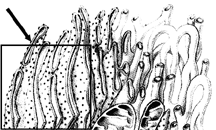Which of the following functions would most likely be occurring in the structure surrounded by the
box in Figure 4-2?
a. apoptosis
b. dynein movement
c. formation of hydrogen peroxide
d. molecular chaperone activity
e. cholesterol synthesis
D
You might also like to view...
Meerkats are small desert mammals that live in groups of 20–50 animals. You observe a female meerkat who spends all of her time caring for the 1-year-old offspring of her sister (her nieces and nephews)
The aunt is capable of reproduction but has not reproduced. Which of the following would contribute to the evolution of this behavior pattern? A. The odds of any one female reproducing are completely random. B. Offspring require the efforts of a single adult (the mother) in order to be successful. C. Offspring require the efforts of at least two adults in order to be successful. D. Offspring are independent at the age of three months, with no adult care after that point.
All amphibians, reptiles, birds, and mammals alive
today a. have jaws. b. are chordates. c. are vertebrates. d. are craniates. e. are craniate, vertebrate chordates with jaws.
Cryptosporidium is an apicomplexian that can contaminate water supplies. Which of the following would you predict to be the case of a Cryptosporidium outbreak?
a. It can only be transmitted by insect bites because it is nonmotile b. It can grow in any water supply because it is photosynthetic c. It will be difficult to treat with chlorine because it forms spores d. It spreads rapidly because it has flagella e. It will enter a person's body through their respiratory tract
You isolate a compound that is insoluble in water, has alternating single and double bonds, and has a
bright orange color. You correctly conclude that this compound is a: a. protein. b. nucleic acid. c. polysaccharide. d. steroid. e. carotenoid.